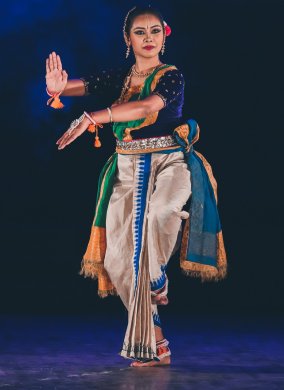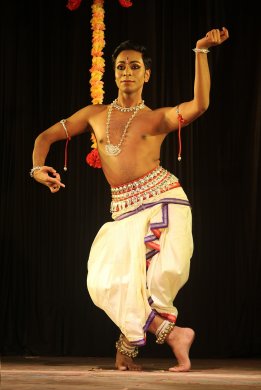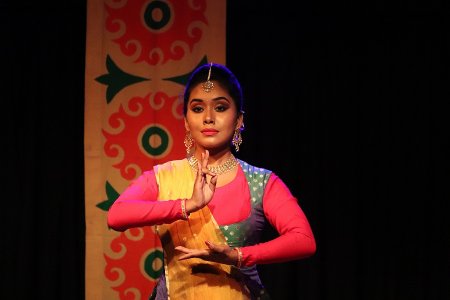
|   |

|   |
 e-mail: ukb7@rediffmail.com Colors of classical choreography Photos courtesy: Manipuri Nartanalaya February 26, 2021 The eastern metropolis has been a fairly late starter in exposing its dance loving population to Indian classical styles, especially without having the benefit of any traditional or ritual forms of its own. With the city's own genesis and growth firmly rooted in the British colonial regime and having a flourishing uber middle class culture, alongside their own educational, mercantile and neo-aristocratic icons, the dance of the highly cultivated tawaifs (nautch girls) and their ilk had served normal entertainment needs till the latter faded with time and changing tastes. This was the scene for nearly two centuries and a half until the political capital shifted from Calcutta to Delhi and even thereafter awaited the curtain-raiser Manipuri dance to be introduced by Tagore, via Santiniketan, for his dance-drama Natir Puja (Worship of the Danseuse), based on Buddhist annals, in 1929. Yet Calcutta seemingly preferred to wait for its Kathakali and Manipuri teachers to come via Santiniketan till Independence and till the Kutty couple - Govindan and Thankamani, groomed in Kathakali and Mohiniyattam respectively - migrated from Kerala Kalamandalam to Calcutta's Dover Lane in the late 1950s and virtually ushered in the classical dance scene here. Since they chose to teach primarily Bharatanatyam to meet the emerging expectations, which was not their professional specialization, the foundations - despite most sincere efforts - remained perhaps shaky. Barring the solitary exception of Manipuri guru Bipin Singh, other celebrated classical gurus did not set sail here, but - following the footsteps of Guru Kelucharan Mohapatra in Odissi and Pt. Birju Maharaj in Kathak - preferred to conduct periodic dance workshops here. Otherwise, most aspiring Kolkata dancers had to look for advanced grooming in other Indian metropolises. It is only recently that, with the emergence of competent second generation gurus, the picture is decidedly changing for the better. The recent classical dance festival with upcoming millennials would bear witness to this conjecture. Purnaya, the young dancers' festival, organized on February 7, 2021 by Manipuri Nartanalaya, admirably supported by Manipur government and conducted by Bimbavati Devi, the talented daughter of Guru Bipin Singh - in a brand new, pocket-size auditorium dedicated to the memory of the recently departed, celebrated dance and theatre person, Usha Ganguly-presented four well-trained youthful artistes. Since all of them used recorded music, names of their accompaniments are not mentioned here.  Kankana Singh Kankana Singh, who opened the evening, was initially trained by her own dancer parents and later groomed both by Manipuri Nartanalaya and academically, having already picked up some exposure and accolade. She began with Krishna Roop Varnan, composed originally by guru Bipin Singh in Kankan (11-beat) and Tanchep (4-beat) talas, as executed by a lovelorn Gopi with eloquent Mridu (lasya) and with an admirable command over the Bhangi Parengs (pure dance). Her second item was Mridu Uddhata Krishna Nartana, another Bipin Singh composition in Tanchep and Chartal (14-beat). Guru Bipin had made copious use of Pung Cholam (dance with drums) and Kartal Cholam (dance with cymbals) in his compositions and this item - visualizing Natabara (dancer) Krishna participating in Raas Lila with Gopis - was an eloquent testimony of the guru's innovative prowess, mirrored in a Krishna persona.  Sourav Samanta Sourav Samanta, who took the stage next, was initially trained in Bharatanatyam, but later came into his own having learnt Odissi under guru Sabarnik De and finally under guru Sutapa Talukdar, and participated in many national and international events. He began with a Mangalacharan invoking Vishnu in his benign form as the final authority on the Vedas and with Laxmi as his consort. The accompanying lyric Khsimanu Kampadhara... was a Kavisurya Baldeva Ratha composition in raga Kedar-Kamodi and set in tala triputa. His second item was a Kirwani Pallavi, allowing him an opportunity to eke out a tapestry of interwoven patterns of music and dance syllables within the same space and time. The Pallavi's pure dance used the Mahari tradition of the Devdasis who performed in the sanctum sanctorum of Puri's Jagannath temple. The choreography was by Guru Kelucharan Mohapatra, with music by Pt Bhubaneswar Misra.  Shantanu Roy The penultimate dancer was Shantanu Roy in Bharatanatyam, slender in appearance, with a Master's degree from Tamil University Thanjavur as well as a few awards, and now receiving training under Samrat Dutta. He began with an invocatory bhajan, Jai Narayana Brahma Parayana Sripati Kamala Kantam..., a Surdas composition from the 16th century, praising Krishna in Brajbhasha. The bhajan went on to narrate three episodes in the charanam segment: Vasudeva grihe janama lio hey, nam dharo Yadunathan... and concluded with Krishna roop dhare asura sanhare Kamsa Kesi nee hantam... The episodes etched out the birth of baby Krishna in the prison of Kamsa, followed by the killing of the demons Kubalaya Peeda and Bakasura. Belying his svelte demeanour, Santanu went from strength to strength in his abhinaya and when he finally concluded with a Sankeertanam where the jeevatma and the paramatma ultimately unites, reaching a crescendo, the small audience clapped synchronously and then rose on their feet giving him a spontaneous standing ovation - a phenomenon rare in this part of the world! The music was in ragamalika and talamalika, with admirable choreography by Samrat Dutta.  Srijita Baidya The last dancer was the youthful Srijita Baidya, all of 21 years and hailing from a small township Chittaranjan, training under guru Ashim Bandhu Bhattacharya for last 10years, also having received top award in Dover Lane Music Conference. A very sprightly dancer, she began her performance with a traditional Guru Vandana, as an invocation to Nataraj Shiva, the Mahaguru. An elaborate nritya Mel Bandhan followed to illustrate the technical aspects of Kathak, consisting of upaj, thaat, amad, tukra, paran and many more. Quite remarkably, she showed her skills in a seamless blend of Jaipur Gharana and Lucknow Gharana. She concluded with abhinaya with a Thumri, Mujhe Rang de sari gulaabi chunariya re, Mose mare nazaria saawaria re... in raga Piloo and tala dadra. The choreography, which expressed the delicate elegance of mugdha nayika at her first sight of love, was choreographed by Ashim Bandhu and she did not belie high expectations. It was quite a satisfying open proscenium evening, after a long and trying Covid time. See video  Dr. Utpal K Banerjee is a scholar-commentator on performing arts over last four decades. He has authored 23 books on Indian art and culture, and 10 on Tagore studies. He served IGNCA as National Project Director, was a Tagore Research Scholar and is recipient of Padma Shri. Post your comments Pl provide your name and email id along with your comment. All appropriate comments posted with name and email id in the blog will also be featured in the site. |